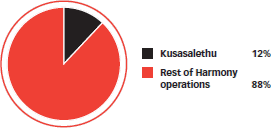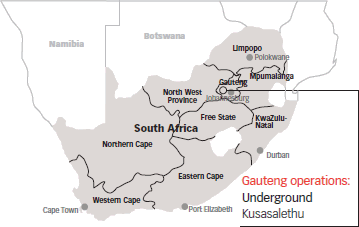![Harmony [logo]](i/logo.png)
![Harmony [logo]](i/print_logo.png)

- Home <
- Business review <
- Review of operations <
- South Africa <
- Kusasalethu
In this section
Kusasalethu
Contribution to group production – FY10


Description
The Kusasalethu mine (formerly Elandsrand), which is located on the Gauteng-North West Province border, comprises twin vertical and twin sub-vertical shaft systems. Mining at Kusasalethu is undertaken using conventional mining methods in a sequential grid layout. The deepening project, which is almost complete, involves the extension of the sub-vertical shafts to access the deeper parts of the Ventersdorp Contact Reef up to a depth of 3 600 metres. Work on the project is currently focussed on accessing and opening up areas of the new mine and the development and construction of the necessary support infrastructure. Ore mined at Kusasalethu is treated at the Kusasalethu plant.
The rebranding and name change of this operation in February 2010 was based on entrenching a culture, endorsed by both management and the unions, to ensure safe, productive mining. The five core values of this new culture are safety as the first priority; accountability; respect; honesty; and rewarding excellence.
Kusasalethu employed 5 685 people – 5 049 employees and 636 contractors – in FY10.
Detailed information on Kusasalethu’s resources and reserves are available in the Mineral resources and mineral reserves section of this annual report.
Safety
Historically, this mine has had a less than impressive safety record which affected the ability to meet targets and achieve plans. Hand-in-hand with the new vision for the mine has gone a concerted effort to focus on creating a safe working environment at Kusasalethu. This has borne fruit and overall safety performance improved in FY10, but there were most regrettably two fatalities (FY09: five fatalities). The LTIFR improved to 6.68 per million hours worked (FY09: 12.67). Seismicity continued to be a risk and steps were taken to improve the quality of the pre-conditioning at the stope face so as to reduce the possibility of face ejection during small, volatile seismic events.
More detailed information on safety performance and Harmony’s sustainable development concerns in South Africa can be found in the online Sustainable Development Report. A summary of this can be found under Harmony and sustainability.
| Production | FY10 | FY09 | FY08 | |
|---|---|---|---|---|
| Volumes milled | 000t (metric) | 1 035 | 962 | 890 |
| 000t (imperial) | 1 141 | 1 061 | 981 | |
| Gold produced | kg | 5 444 | 5 422 | 5 108 |
| oz | 175 029 | 174 321 | 164 215 | |
| Average grade | g/t | 5.26 | 5.64 | 5.74 |
| oz/t | 0.153 | 0.164 | 0.167 | |
| Financial | ||||
| Revenue | R million | 1 392 | 1 422 | 964 |
| US$ million | 184 | 158 | 133 | |
| Operating cost* | R/kg | 208 864 | 191 097 | 152 611 |
| US$/oz | 857 | 660 | 652 | |
| Operating profit | R million | 301 | 366 | 213 |
| US$ million | 40 | 41 | 30 | |
| Capital expenditure | R million | 430 | 422 | 318 |
| US$ million | 57 | 47 | 44 | |
| Sustainability | ||||
| Number of employees | ||||
| Employees | 5 049 | |||
| Contractors | 636 | |||
| Total | 5 685 | |||
| HDSAs in management** | % | 33 | ||
| Women in mining** | % | 10 | ||
| Expenditure on training and development | R million | 39 | ||
| Safety | ||||
| No. of fatalities | 2 | |||
| LTIFR | per million hours worked | 6.68 | ||
| Environment | ||||
| Energy used | 000MWh | 629 | ||
| Water used for primary activities | 000m3 | 2 138 | ||
| GHG emissions | 000t CO2e | 765 | ||
| Expenditure on local economic development | R million | 10 | ||
| Status of mining right | New order mining right granted in December 2007 | |||
* Includes royalty payment in FY10
** Indicator reported in terms of the MPRDA and the South African Mining Charter
Operations review
Although volumes milled rose by 8% to just over 1Mt, a 7% decline in grade resulted in gold produced being just fractionally higher on the 2009 financial year at 175 029 ounces. Currently, 60% of production at Kusasalethu is from production areas below 100 level (the new mine expansion project) and 40% from production areas in the ‘old’ mine, above 100 level.
Underperformance on square metres broken was the mine’s biggest challenge in FY10. Scaling in the main reef and waste ore pass systems resulted in blockages in both systems, which contributed to waste dilution and resulted in the lower recovered grade during the year.
By year-end it was decided to separate reef and waste and to continue with the removal of the blockage in the waste pass system between the old mine (above 100 level) and the new mine (below 100 level). Once the blockage has been removed, waste rock and reef ore will again be tipped into one ore pass system to accommodate the rehabilitation of both ore pass systems. While this will dilute the recovered grade, it will not affect gold production.
Productivity, which is currently at 84g/TEC, is a concern. Plans are in place to increase this to 158g/TEC in 2013, once peak production has been achieved, by increasing volumes from the new mine where the mining operation is more efficient. The mine deepening project infrastructure is 95% complete. The shaft infrastructure is in place and work over the next two years will focus mainly on the provision of sufficient cooling and ventilation into the new mine areas.
Financial review
The stronger rand over the year has resulted in revenue in rand terms declining by 2% to R1 392 million, negating the effect of the higher dollar gold price received. Cash operating cost rose by 9% to R208 864/kg and by 30% to $857/oz, also a function of the strength of the rand. This also had an impact on cash operating profit which declined by 18% in rand terms to R301 million and by 2% in dollars terms to $40 million.
Capital expenditure for the year totalled R430 million ($57 million), spent mostly on on-going development (R266 million), the maintenance of equipment (R34 million) and development of the new mine project (R90 million).
Outlook*
The planned build-up in production at Kusasalethu will continue in line with the life-of-mine plan for the new mine project. Milling volumes of 1.3 million tonnes are planned for FY11, at an average grade of 5.16g/t, yielding 200 000oz. Once levels 109 and 113 have come into production by July 2013, gold output is scheduled to rise to more than 300 000oz. The grade mined will increase progressively, averaging 6.45g/t, as the mine reaches full production by 2013 and as more mining takes place in the high-grade facies where the Elsburg Reef sub-outcrops against the Ventersdorp Contact Reef, causing localised enrichment on the western side of the mining lease area.
Total capital expenditure** planned for FY11 is R414 million (US$54 million) – R284 million (US$37 million) on on-going development, R39 million (US$5 million) on major equipment maintenance and R39 million (US$5 million) on other shaft capital. The balance of R52 million (US$7 million) is planned for the Kusasalethu new mine project.
* Please refer to the forward-looking statements
** June 2010 money terms. The exchange rate of R7.63/US$ as at 30 June 2010 has been used for all forward-looking conversions.
HARMONY ANNUAL REPORT 2010